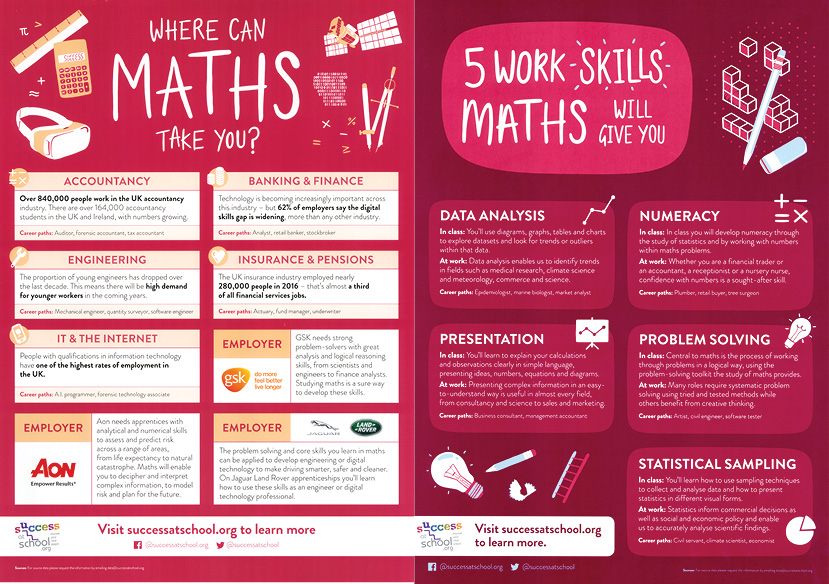Mathematics
Key Stage 3 (Year 7-9)
Year 7
Year 7 Lovelace & Turing (7yMa1, 7yMa2, 7yMa3, 7yMa4, 7xMa1, 7xMa2, 7xMa3)
- Place value
- Properties of arithmetic
- Factors and multiples
- Prime factor decomposition
- Order of operations
- Positive and negative numbers
- Expressions, equations and inequalities
- Coordinates
- Angles
- Classifying 2D shapes
- Area of 2D shapes
- Conceptualising and comparing fractions
- Manipulating and calculating with fractions
- Ratio
- Transforming 2D shapes
Year 7 Newton (7yMa5, 7xMa4)
- Number
- Multiplicative relationships
- Additive relationships
- Positive and negative numbers
- All four operations
- Factors and multiples
- Angles and symmetry
- Shape and measure
- Coordinates
- Area
- What is a fraction?
- Equivalent fractions
- Operations acting on fractions
- Ratio
- Decimal and fractions
- Percentages
- Time
Year 8
Year 8 Lovelace & Turing (8yMa1, 8yMa2, 8yMa3, 8yMa4, 8xMa1, 8xMa2, 8xMa3)
- Sequences
- Forming and solving equations
- Forming and solving inequalities
- Linear graphs
- Accuracy and estimation
- Ratio review
- Real life graphs
- Direct and inverse proportion
- Univariate data
- Bivariate data
- Angles in polygons
- Bearings
- Circles
- Volume and surface area of prisms
Year 8 Newton (8yMa5, 8xMa4)
- Addition and subtraction of integers and decimal numbers
- Multiplication and division
- Factors and multiples
- Introduction to fractions
- Improper and mixed fractions
- Calculating with fractions
- Decimals & Percentages
- Sequences, order of operation and word problem including negative numbers
- Algebra
- Parallel and perpendicular lines and angles
- Area
- Ratio
- Measure and unit conversions
- Mean
- Calculator skills and rounding
Year 9
Year 9 Lovelace & Turing (9yMa1, 9yMa2, 9yMa3, 9yMa4, 9xMa1, 9xMa2, 9xMa3)
- Fractions Decimals and Percentages review
- Probability
- Sets, Venn’s and sample space diagrams
- Solving algebraically
- Solving graphically
- Angle review
- Constructions, congruence and loci
- Pythagoras’ Theorem
- Ratio review
- Similarity and enlargement
- Trigonometry
- Algebra review
- Quadratic expressions and equations
- Surds
- Indices
- Standard form
- Growth and decay
Year 9 Newton (9yMa5, 9xMa4)
- Fractions Decimal Percentages
- Rounding and BIDMAS
- Probability and Statistics
- Solving algebraically
- LCM and HCF
- Coordinates and linear graphs
- Angle in parallel lines and polygons
- Pythagoras
- Ratio and proportion
- Measures, perimeter and area
- Circles
Key Stage 4 (Year 10-11)
Year 10
Year 10 Higher
Unit 1: Surds and Indices
Unit 2: Equations and Inequalities
Unit 3: Rearranging
Unit 4: Quadratics
Unit 5: Averages, Quartiles and Statistical Graphs
Unit 6: Advanced Fractions
Unit 7: Growth and Decay
Unit 8: Ratio and Proportion
Unit 9: Equations of Graphs
Unit 10: Similarity, Congruence and Transformations
Unit 11: Trigonometry
Unit 12: Bearings
Unit 13: Volume and Surface Area
Unit 14: Compound Measures and Bounds
Year 10 Foundation
Unit 1: Indices and Roots
Unit 2: Algebraic Expressions
Unit 3: Equations and Inequalities
Unit 4: Function Machines
Unit 5: Averages and Statistical Graphs
Unit 6: Fractions
Unit 7: Percentages
Unit 8: Ratio
Unit 9: Proportion
Unit 10: Coordinates and Transformations
Unit 11: Angles
Unit 12: Area and Perimeter
Unit 13: Compound Measures and Rounding
Year 11
Year 11 Higher
Unit 1: Surds and Indices
Unit 2: Quadratics
Unit 3: Algebraic Fractions
Unit 4: Probability Trees and Venn Diagrams
Unit 5: Functions
Unit 6: Iterations
Unit 7: Circle Theorems
Unit 8: Advanced Trigonometry
Unit 9: Graph Transformations
Unit 10: Averages on Histograms
Unit 11: Complete The Square and Proofs
Unit 12: Vectors
Unit 13: Coordinate Geometry
Unit 14: Speed Time and Velocity Time Graphs
Unit 15: Sequences
Unit 16: Loci and Constructions
Year 11 Foundation
Unit 1: FDP Conversions
Unit 2: Expressions
Unit 3: Equations and Inequalities
Unit 4: Area and Perimeter
Unit 5: Angles
Unit 6: Ratio and Proportion
Unit 7: Fractions and Percentages Calculations
Unit 8: Pie Charts
Unit 9: HCF and LCM
Unit 10: Shape Transformations
Unit 11: Probability
Unit 12: Surface Area and Volume
Unit 13: Standard Form
Unit 14: Quadratics
Unit 15: Loci and Constructions
KS5
Year 12 & 13
Mathematics A-Level: Students study a variety of topics across the two years of A Level Mathematics.
The Pearson Edexcel Level 3 Advanced GCE in Mathematics consists of three externally examined papers.
Students must complete all assessment in May/June in any single year.
Paper 1: Pure Mathematics 1 – Written examination: 2 hours (calculator)
33.33% of the qualification
100 marks
Content:
Proof; algebra and functions; coordinate geometry in the (x, y) plane; sequences and series; trigonometry; exponentials and logarithms; differentiation; integration and vectors.
Paper 2: Pure Mathematics 2 – Written examination: 2 hours (calculator)
33.33% of the qualification
100 marks
Content:
Proof; algebra and functions; coordinate geometry in the (x, y) plane; sequences and series; trigonometry; differentiation; integration and numerical methods.
Paper 3: Statistics and Mechanics – Written examination: 2 hours (calculator)
33.33% of the qualification
100 marks
The paper comprises of two sections: section A (statistics) and section B (mechanics).
Content:
Section A – Statistical sampling; data presentation and interpretation; probability; statistical distributions and statistical hypothesis testing.
Section B – Quantities and units in mechanics, kinematics, forces and newton’s laws and moments.
Students study a variety of topics across the two years of A Level Further Mathematics.
The Pearson Edexcel Level 3 Advanced GCE in Further Mathematics consists of four externally examined papers.
Students must complete all assessment in May/June in any single year.
Paper 1: Further Pure Mathematics 1 – Written Examination: 1 hour and 30 minutes (calculator)
25% of the qualification
75 marks
Content:
Proof; complex numbers; matrices; further algebra and functions; further calculus and further vectors.
Paper 2: Further Pure Mathematics 2 – Written Examination: 1 hour and 30 minutes (calculator)
25% of the qualification
75 marks
Content:
Complex numbers; further algebra and functions; further calculus, polar coordinates, hyperbolic functions and differential equations.
Paper 3: Further Pure 1 – Written Examination: 1 hour and 30 minutes (calculator)
25% of the qualification
75 marks
Content: vectors, conic sections, inequalities, the t-formulae, the Taylor series, methods in calculus, numerical methods, reducible differential equations
Paper 4: Further Pure 2 - Written Examination: 1 hour and 30 minutes (calculator)
25% of the qualification
75 marks
Content: number theory, groups, complex numbers, recurrence relations, matrix algebra, integration techniques
Independent Learning Resources
Key Stage 3
-
Use the Oak National Academy website to revise and reinforce the content taught in lessons.
- Start with the lesson's starter quiz to assess your initial understanding.
- Watch the lesson video to reinforce key concepts.
- Complete the exit quiz to test your knowledge.
- If your score is low, re-watch the video and redo the quiz to improve understanding.
Year 7 link: https://www.thenational.academy/pupils/programmes/maths-secondary-year-7-l/units
Year 8 link: https://www.thenational.academy/pupils/programmes/maths-secondary-year-8/units
Year 9 link: https://www.thenational.academy/pupils/programmes/maths-secondary-year-9/units
Please note students do not require a login to access this website.
Use the Century tech website https://app.century.tech/login/ to search topics that you have missed or found difficult via the ‘my courses’ tab. Weekly homework is set on this platform. Login details are provided at the start of the academic year.
Key Stage 4
Exam Board: Pearson Edexcel
How To Revise Maths
1. Use flashcards or a notepad to make notes on key facts/formulae that you need to memorise. You could use a revision guide or checklist to help you find these facts
2. Repeatedly test your knowledge of these facts (self-quiz or get a parent/sibling/friend to quiz you)
3. Practise exam papers and identify topics in need of attention. You can buy packs of practice papers. You can also find free Edexcel papers on mathsgenie.com and corbettmaths.com. If you're in Year 10, only focus on the Foundation Tier for now until you've covered enough content on Higher Tier.
4. If you get stuck when doing a practice paper, ask your teacher for help or use online videos to learn those topics (on century.tech, mathsgenie.com or corbettmaths.com)
5. Use a revision workbook (any Pearson Edexcel book) or website (eg. century.tech or maths genie) to practise the topics that you need to improve on so you don’t make the same mistake again on the next test that contains these topics
Key Stage 5
Use www.uplearn.co.uk to revise previously taught topics and complete pre-learning for upcoming topics. Uplearn is set for homework every week but can also be used as an independent learning resource. Students should watch the videos and complete quizzes in order to boost their Up Score and gain XP.
Careers Advice








